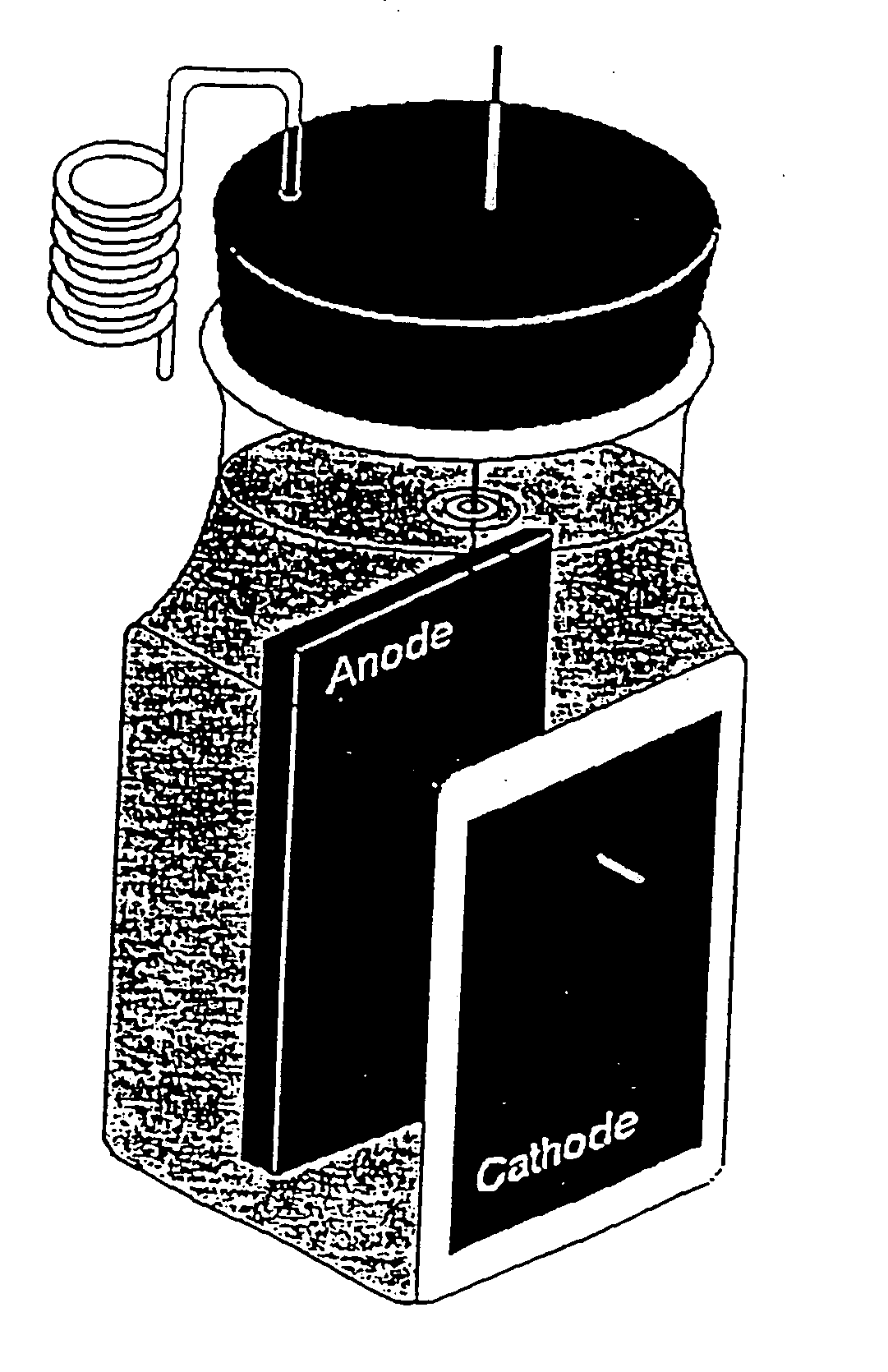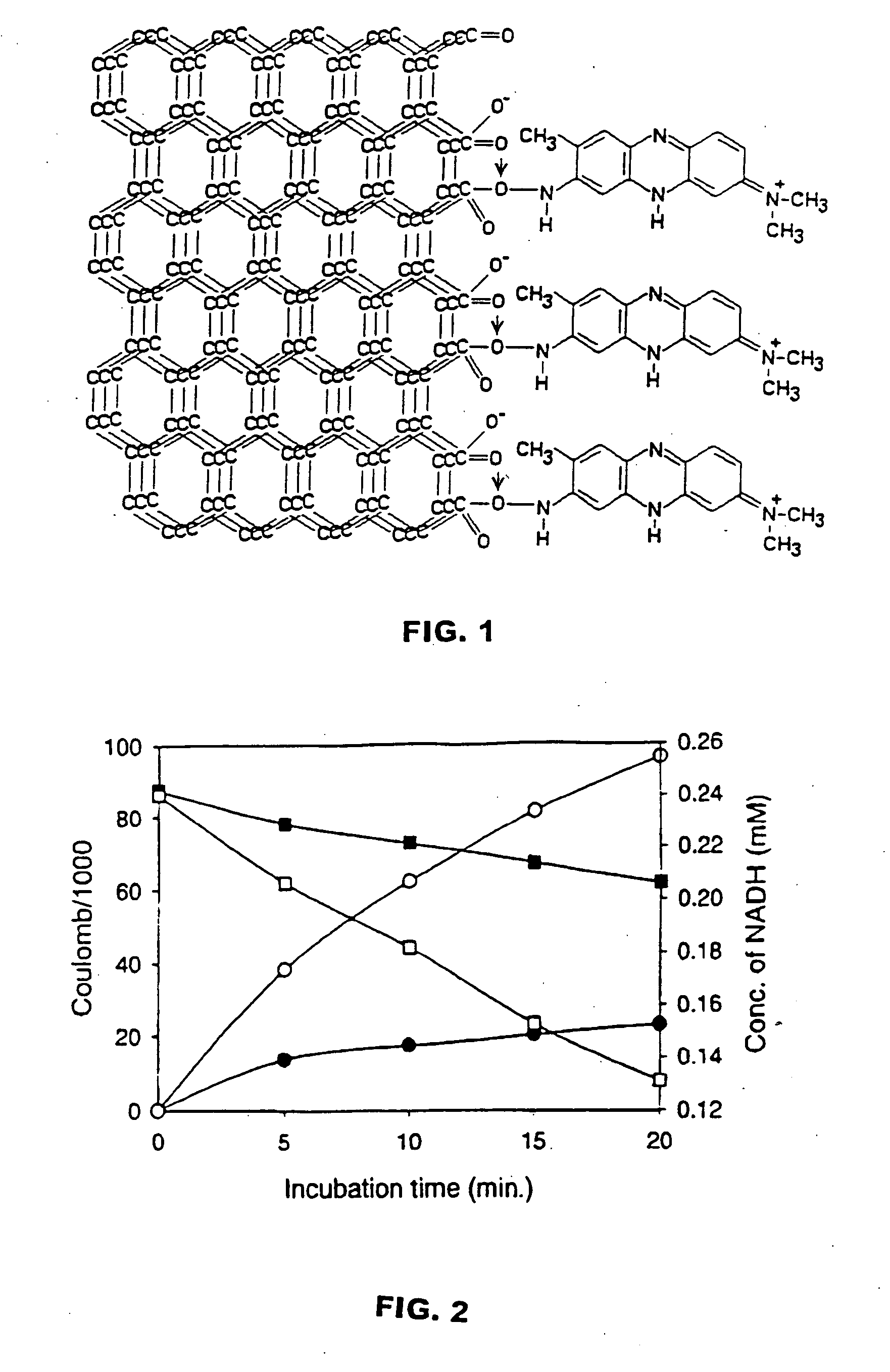Electrode compositions and configurations for electrochemical bioreactor systems
a bioreactor and electrochemical technology, applied in the direction of electrochemical methods, diaphragms, water/sewage treatment, etc., can solve the problems of generally inapplicability of two-compartment fuel cells, and achieve the effect of enhancing the rate of electron transfer
- Summary
- Abstract
- Description
- Claims
- Application Information
AI Technical Summary
Benefits of technology
Problems solved by technology
Method used
Image
Examples
example 1
Microbial Preparations and Measurements
[0059] Sewage sludge (i.e., a mixture of anaerobic bacteria) was obtained from the Jackson, Mich., USA, sewage treatment plant. The fresh anaerobic sludge was allowed to settle under an N2 atmosphere for 1 day to remove solid particles. The suspended cells were used as a catalyst and were maintained in an anaerobic bottle by adding glucose (5 g / L) once a week. The resting cells were harvested by centrifugation at 5,000×g at 4° C. and were washed twice and resuspended in anolyte medium 1. Anolyte medium I contained: 100 mM phosphate buffer (pH 7.0), 10 g / L sodium lactate, 5 g / L peptone and 5 g / L yeast extract. The initial concentration of sewage sludge cell suspension was adjusted to 5.5 mg / ml cell protein as determined (see, Park and Zeikus, “Utilization Of Electrically Reduced Neutral Red By Actinobacillus Succinogenes: Physiological Function Of Neutral Red In Membrane-Driven Fumarate Reduction And Energy Conservation”, J. Bacteriol. 1812:240...
example 2
Electrode Compositions
[0061] A procedure to covalently link neutral red to woven graphite felt was developed (see FIG. 1). The theoretical surface area of the woven graphite felt anode is 1.27 m2(2.7 g) versus a graphite plate anode with approximately 80 cm2. This procedure involved the following steps: (1.) cleaning the graphite felt electrode by soaking in methanol for 12 hours and then distilled water for 12 hours; (2.) drying the electrode at 120° C. for 1 hour; (3) making a carboxy surface by heating at 200° C. for 48 hours; (4) soaking the electrode in dicyclohexylcarbodimide solution (2 mg / ml chloroform) at 4° C. for 6 hours; (5) binding neutral red (100 μmol) to the electrode by incubating the dicyclohexylcarbodimide solution at 4° C. for 12 hours. The neutral red was immobilized to the electrode by this procedure and did not leach-out in water.
[0062] Several different metallic graphite electrodes were designed so as to compare their electron transfer efficiencies to neutr...
example 3
Fuel Cell Design and Operation
[0064] Two compartment cell fuel cells were prepared using the configuration described in Park and Zeikus, “Electricity Generation In Microbial Fuel Cells Using Neutral Red And An Electronophore”, Appl. Environ. Microbiol., 66:1292-1297, 2000, except for using the electrodes prepared in Example 2; and the cation selective membrane was replaced with a 50 mm by 2 mm thick porcelain septum made from 100% Kaolin as described above in Example 2. The two compartment fuel cell of Park and Zeikus, “Electricity Generation In Microbial Fuel Cells Using Neutral Red And An Electronophore”, Appl. Environ. Microbiol., 66:1292-1297, 2000 requires aeration and ferricyanide solution in the cathode compartment.
[0065] Because two compartment fuel cells are generally not practical because of the requirement for a ferricyanide solution and aeration in the cathode compartment, single compartment fuel cell design as shown in FIGS. 3 and 4 was prepared in order to eliminate ...
PUM
| Property | Measurement | Unit |
|---|---|---|
| total volume | aaaaa | aaaaa |
| surface area | aaaaa | aaaaa |
| pH | aaaaa | aaaaa |
Abstract
Description
Claims
Application Information
 Login to View More
Login to View More - R&D
- Intellectual Property
- Life Sciences
- Materials
- Tech Scout
- Unparalleled Data Quality
- Higher Quality Content
- 60% Fewer Hallucinations
Browse by: Latest US Patents, China's latest patents, Technical Efficacy Thesaurus, Application Domain, Technology Topic, Popular Technical Reports.
© 2025 PatSnap. All rights reserved.Legal|Privacy policy|Modern Slavery Act Transparency Statement|Sitemap|About US| Contact US: help@patsnap.com



